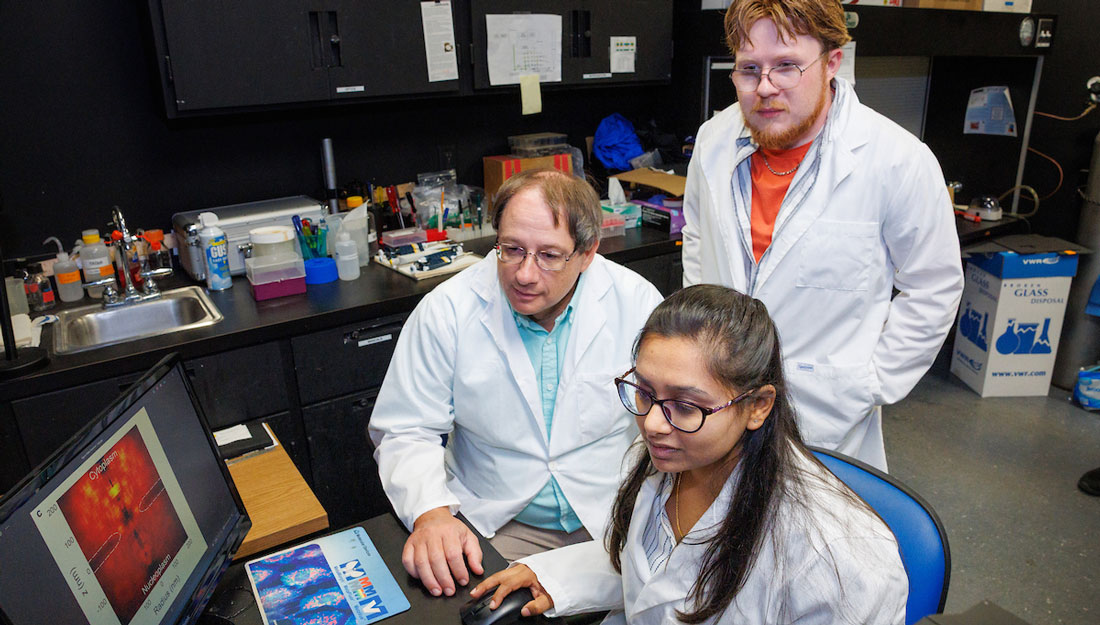- Gracie Blackwell
- Featured, Medicine, Research, Show on VR homepage
Smoking cessation drug may treat Parkinson’s in women
College of Medicine researchers find evidence for the use of a drug that reduces the loss of dopamine neurons in female animal models

Decorative image of the brain
There are approximately 10 million people worldwide living with Parkinson’s disease, a neurodegenerative disorder that leads to a variety of movement-related symptoms—difficulty in walking, tremors, shaking—and non-movement-related symptoms—depression, constipation, sleep problems—that negatively affect a person’s way of living. These symptoms start to develop when at least 50 percent of dopamine neurons in an individual’s brain are dead or impaired. Currently, there is no cure for Parkinson’s and no treatment that can stop or prevent the loss of these dopamine neurons that are needed for the body to move.
Using an animal model, researchers from the Texas A&M University College of Medicine have recently discovered that cytisine—a smoking cessation drug commonly used in Europe—reduces the loss of dopamine neurons in females. These findings provide potential evidence for the use of this drug to treat Parkinson’s disease or stop its progression in women.
Sara Zarate and Gauri Pandey, graduate students from the lab of Rahul Srinivasan, MBBS, PhD, assistant professor in the Department of Neuroscience & Experimental Therapeutics at the Texas A&M College of Medicine, are co-first authors of this research that was published in the Journal of Neurochemistry.
About a decade ago, Srinivasan became interested in trying to understand a remarkable phenomenon: smokers and people who consume tobacco chronically are at a lower risk for developing Parkinson’s disease.
“Based on epidemiological studies, this phenomenon has been known for about 60 years,” Srinivasan said. “But people really don’t understand why that is, because tobacco and smoke contain so many different chemicals. One of the chemicals obviously is nicotine, and that explains the addictive properties of tobacco and cigarette smoke. So, I started to study the potential role of nicotine in this protective effect against Parkinson’s disease.”
Given the fact that it is very difficult to conduct human and animal trials using nicotine due to severe side-effects, Srinivasan decided to test cytisine as an alternative to nicotine. Cytisine is a smoking cessation drug with properties similar to nicotine, but with very few side effects in people.
“What cytisine does is it binds to target receptors but doesn’t activate them as efficiently as nicotine,” Srinivasan said. “It keeps the receptors ‘occupied’ and ‘chaperones’ them to the surface of the neuron. Since cytisine is a natural compound, is available quite freely and is pretty cheap, I decided to test this concept of chaperoning in an animal model of the disease to see if it works.”
During the experiments, the team artificially induced Parkinson’s disease in animal models. During that time, they either gave them saline (salt water) or cytisine. Then, the researchers performed a series of behavioral experiments in order to see if there was any sort of protective effect on the animal models that were given cytisine.
Their findings showed that there was a protective effect both in terms of reducing the Parkinsonian behaviors and also in terms of reducing the number of dopamine neurons lost. However, the protective effect of cytisine occurred only in female animal models, and not in the males. They discovered that the combination of cytisine and estrogen produces a stronger protective effect than cytisine and no estrogen. Thus, this explains why the effect only occurred in female animal models, since males do not have appreciable amounts of estrogen.
Although their findings currently only apply to females, Srinivasan hopes to find solutions for males and postmenopausal females too.
“What is really interesting is that there are non-feminizing compounds that have been developed and are being researched right now that can activate the receptors that estrogen activates,” Srinivasan said. “The goal right now is to understand how estrogen triggers the protection in female animal models. Once we fully understand this component, then we can bring in these non-feminizing estrogen analogs, and we will potentially have a combination therapy of cytisine and a non-feminizing estrogen analog for men.”
The next step for Srinivasan and his team is to solidify and confirm the role of estrogen specifically as a protective effect against Parkinson’s disease.
“At the face of it, this drug is ready to be used today in women with Parkinson’s, but as is true for all drugs, you cannot get approval for a drug until you understand what the mechanism of the actual drug is exactly, which is our next step,” Srinivasan said. “This first paper is the description of a protective effect and a potential mechanism for cytisine against Parkinson’s disease. The next steps are to nail down the mechanisms by which this is happening, the role of estrogen specifically. Once we do that, we will use cytisine for women before menopause or cytisine combined with non-feminizing estrogen analogs for both men and women, including women after menopause.”
Media contact: media@tamu.edu


